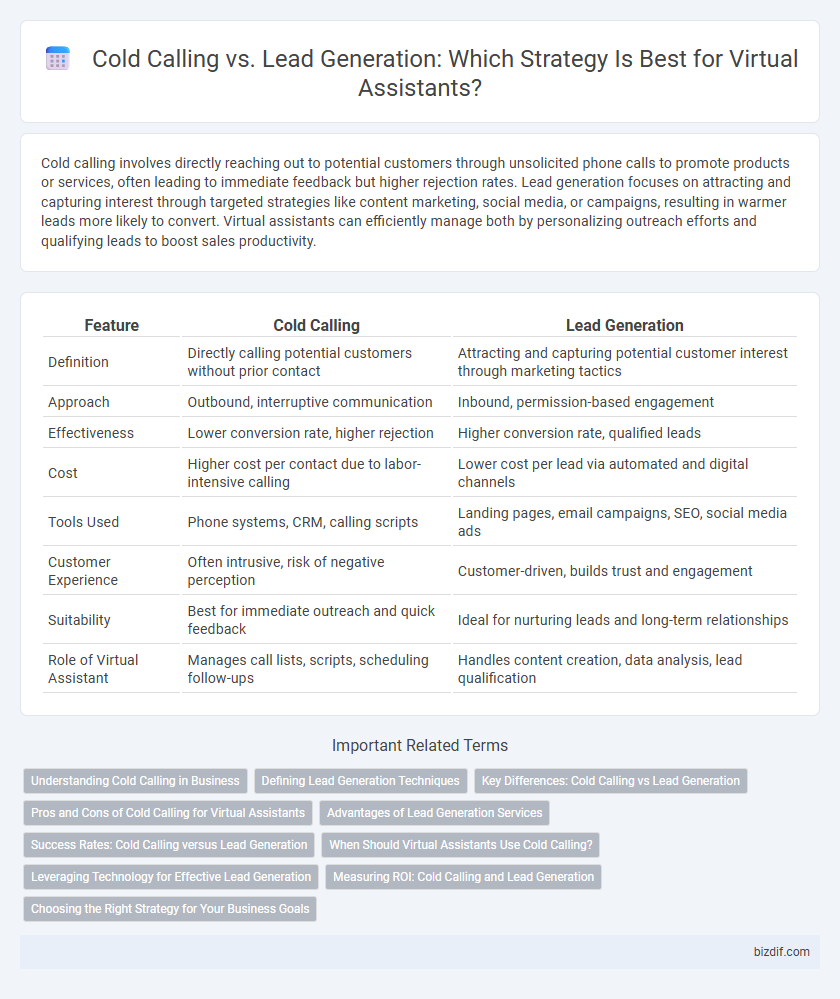Cold calling involves directly reaching out to potential customers through unsolicited phone calls to promote products or services, often leading to immediate feedback but higher rejection rates. Lead generation focuses on attracting and capturing interest through targeted strategies like content marketing, social media, or campaigns, resulting in warmer leads more likely to convert. Virtual assistants can efficiently manage both by personalizing outreach efforts and qualifying leads to boost sales productivity.
Table of Comparison
| Feature | Cold Calling | Lead Generation |
|---|---|---|
| Definition | Directly calling potential customers without prior contact | Attracting and capturing potential customer interest through marketing tactics |
| Approach | Outbound, interruptive communication | Inbound, permission-based engagement |
| Effectiveness | Lower conversion rate, higher rejection | Higher conversion rate, qualified leads |
| Cost | Higher cost per contact due to labor-intensive calling | Lower cost per lead via automated and digital channels |
| Tools Used | Phone systems, CRM, calling scripts | Landing pages, email campaigns, SEO, social media ads |
| Customer Experience | Often intrusive, risk of negative perception | Customer-driven, builds trust and engagement |
| Suitability | Best for immediate outreach and quick feedback | Ideal for nurturing leads and long-term relationships |
| Role of Virtual Assistant | Manages call lists, scripts, scheduling follow-ups | Handles content creation, data analysis, lead qualification |
Understanding Cold Calling in Business
Cold calling in business involves directly reaching out to potential customers via phone to generate immediate interest in products or services, aiming for quick engagement and conversion. It requires skilled communication to overcome objections and build rapport within a short interaction, making it a high-pressure yet potentially rewarding sales tactic. Unlike broader lead generation strategies, cold calling targets specific prospects without prior contact, emphasizing real-time dialogue to quickly qualify leads.
Defining Lead Generation Techniques
Lead generation techniques involve identifying potential customers through targeted methods such as social media marketing, email campaigns, and content creation to attract and engage prospects organically. Unlike cold calling, which relies on direct, unsolicited phone outreach, lead generation focuses on nurturing qualified leads by providing valuable information and personalized interactions. Effective lead generation strategies leverage data analytics and customer profiling to optimize conversion rates and build long-term relationships.
Key Differences: Cold Calling vs Lead Generation
Cold calling involves directly contacting potential customers via phone to initiate sales conversations without prior interaction, while lead generation focuses on attracting and capturing interest through marketing strategies to build a pool of qualified prospects. Key differences include cold calling's proactive outreach versus lead generation's inbound approach, and cold calling typically yields immediate responses whereas lead generation nurtures leads over time. Virtual assistants can streamline both processes by managing call lists, scheduling follow-ups, and optimizing lead tracking to enhance sales efficiency.
Pros and Cons of Cold Calling for Virtual Assistants
Cold calling for virtual assistants offers immediate engagement and the opportunity to gather direct feedback, enhancing customer interaction skills. However, it often encounters high rejection rates and can be time-consuming, impacting overall productivity. This method requires careful scripting and persistence to convert prospects effectively, balancing effort with potential lead quality.
Advantages of Lead Generation Services
Lead generation services enhance targeting efficiency by identifying high-quality prospects through data-driven analysis, increasing conversion rates significantly. These services reduce time spent on unqualified contacts, allowing virtual assistants to focus on nurturing genuine leads with personalized communication. Leveraging advanced CRM tools, lead generation streamlines the sales funnel, ultimately boosting ROI and accelerating business growth.
Success Rates: Cold Calling versus Lead Generation
Cold calling typically yields lower success rates compared to lead generation due to increased consumer resistance and higher rejection frequency, with conversion rates often ranging from 1% to 3%. Lead generation methods, leveraging targeted data and digital marketing strategies, generally achieve higher success rates between 10% and 20% by attracting qualified prospects actively seeking solutions. Optimizing campaigns through CRM integration and data analytics further enhances lead generation success, maximizing return on investment in virtual assistant-driven sales efforts.
When Should Virtual Assistants Use Cold Calling?
Virtual assistants should use cold calling when targeting new, unqualified prospects to initiate direct conversations and quickly assess interest in products or services. Cold calling is effective for obtaining immediate feedback, gathering market information, and creating initial contact streams that can be nurtured through lead generation strategies. This approach works best in industries with high call receptiveness and when personalization can be tailored to specific demographic or firmographic criteria.
Leveraging Technology for Effective Lead Generation
Leveraging technology for effective lead generation includes utilizing CRM systems, AI-driven data analysis, and automated email marketing platforms to identify and nurture potential clients more efficiently than traditional cold calling methods. Virtual assistants can streamline lead qualification through predictive analytics and personalized outreach, increasing conversion rates while reducing time spent on non-productive calls. Integrating chatbots and social media automation further enhances lead capture and engagement, making lead generation a scalable and targeted process.
Measuring ROI: Cold Calling and Lead Generation
Measuring ROI in cold calling involves tracking metrics such as call-to-conversion rates, average deal size, and sales cycle length to evaluate direct revenue impact. Lead generation ROI focuses on analyzing lead quality, cost per lead, and conversion rates from marketing campaigns to optimize customer acquisition costs. Comparing these metrics enables businesses to allocate resources effectively between high-touch sales efforts and scalable marketing strategies.
Choosing the Right Strategy for Your Business Goals
Cold calling offers direct, immediate customer engagement but often faces lower conversion rates and higher rejection, making it suitable for businesses prioritizing quick outreach and personal interaction. Lead generation focuses on attracting and nurturing potential clients through targeted marketing campaigns and content distribution, which aligns with long-term growth and higher-quality prospects. Selecting the right strategy depends on your business goals, whether you prefer rapid contact with prospects or cultivating a qualified lead pipeline for sustained sales success.
Cold calling vs Lead generation Infographic

 bizdif.com
bizdif.com